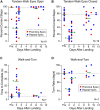Mission-critical tasks for assessing risks from vestibular and sensorimotor adaptation during space exploration
- PMID: 36505047
- PMCID: PMC9733831
- DOI: 10.3389/fphys.2022.1029161
Mission-critical tasks for assessing risks from vestibular and sensorimotor adaptation during space exploration
Abstract
To properly assess the risk induced by vestibular and sensorimotor adaptation during exploration missions, we examined how long-duration stays on the International Space Station affect functional performance after gravity transitions. Mission-critical tasks that challenge the balance and the locomotion control systems were assessed: i.e., sit-to-stand, recovery-from-fall, tandem-walk, and walk-and-turn. We assessed 19 astronauts, including 7 first-time flyers and 12 experienced flyers, before their flight, a few hours after landing, and then 1 day and 6-11 days later. Results show that adaptation to long-term weightlessness causes deficits in functional performance immediately after landing that can last for up to 1 week. No differences were observed between first-time and experienced astronaut groups. These data suggest that additional sensorimotor-based countermeasures may be necessary to maintain functional performance at preflight levels when landing on planetary surfaces after a long period in weightlessness.
Keywords: adaptation; functional performance; sensorimotor system; spaceflight; vestibular tests.
Copyright © 2022 Clément, Moudy, Macaulay, Bishop and Wood.
Conflict of interest statement
Authors GC, TM, and MB were employed by KBR. Author SM was employed by Aegis Aerospace. The remaining authors declare that the research was conducted in the absence of any commercial or financial relationships that could be construed as a potential conflict of interest.
Figures




References
-
- Chavers G., Bleacher J., Craig D., Mahoney E., McCauley R., McIntyre N., (2021). “Long-term architecture development for the moon and Mars,” in 72nd international astronautical congress (Dubai, UAE: International Astronautical Federation; ).
LinkOut - more resources
Full Text Sources

